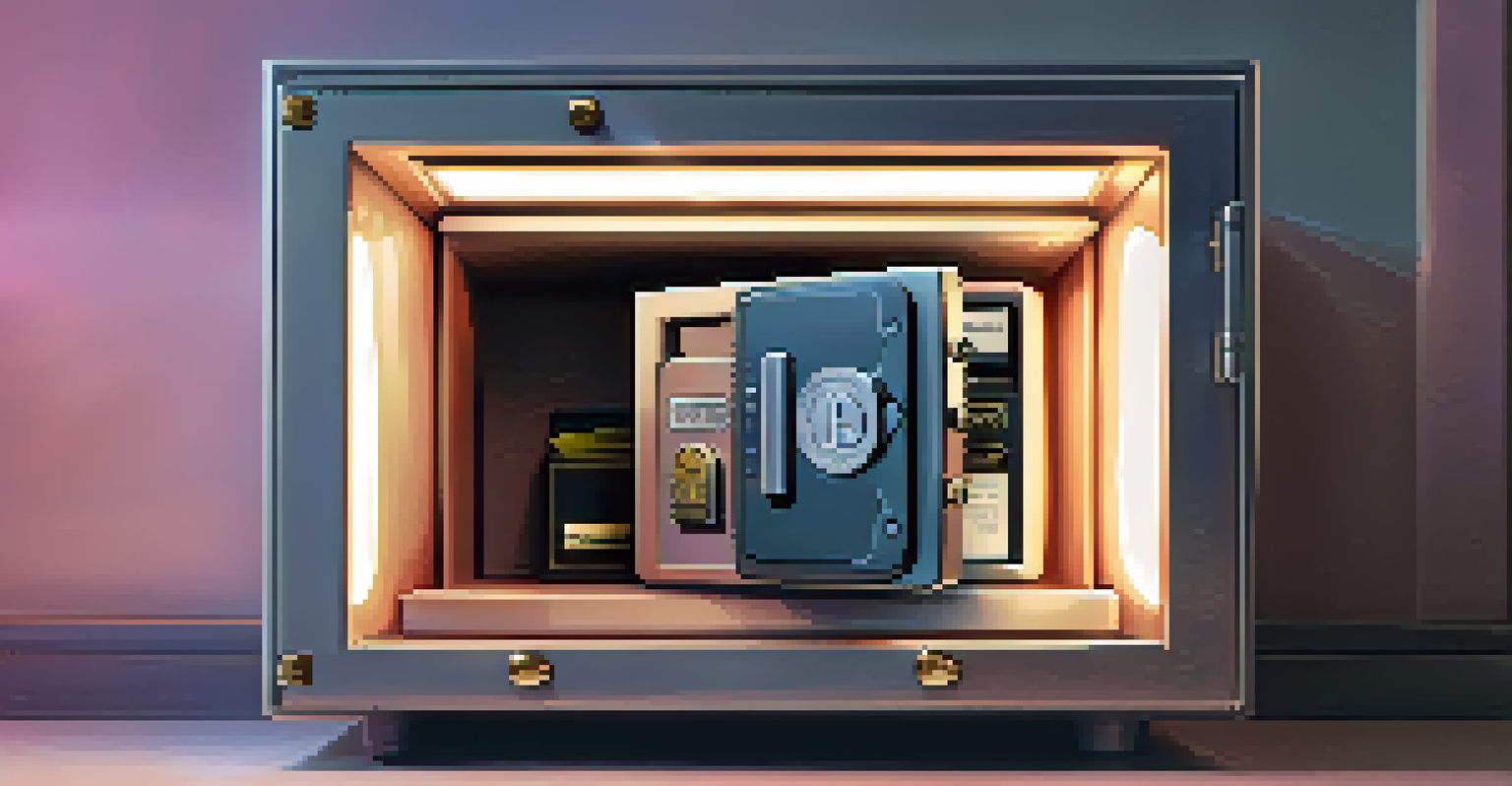Cold Wallets for Bitcoin: Secure Storage Options Explained

What Are Cold Wallets and Why Use Them?
Cold wallets, often referred to as cold storage, are offline tools designed to securely store Bitcoin and other cryptocurrencies. Unlike hot wallets, which are connected to the internet and vulnerable to hacks, cold wallets provide a more secure method of keeping your digital assets safe. This makes them a popular choice for long-term investors who don’t need immediate access to their funds.
The best way to store your Bitcoin is to keep it offline, away from the prying eyes of hackers.
The primary appeal of cold wallets lies in their ability to protect against cyber threats. By keeping your private keys offline, you significantly reduce the risk of unauthorized access. Think of it like storing your cash in a safe at home rather than carrying it around in your wallet—it's just safer that way.
In a world where cybersecurity is a growing concern, understanding the concept of cold wallets is crucial. They serve as a fortress for your Bitcoin, ensuring that your investment remains secure from the prying eyes of hackers.
Types of Cold Wallets: A Closer Look
There are several types of cold wallets, each with its unique features and benefits. Hardware wallets, like Ledger and Trezor, are physical devices designed specifically for the secure storage of cryptocurrencies. They are user-friendly and offer a robust level of security, making them ideal for both beginners and seasoned investors.

Paper wallets are another option, where your Bitcoin is stored in the form of printed QR codes and keys. While this method is cost-effective, it requires careful handling to avoid loss or damage. Imagine writing down your passwords on a piece of paper and hiding it away; it’s secure, but you must remember where you put it!
Cold Wallets Enhance Security
Cold wallets protect your cryptocurrencies by keeping private keys offline, significantly reducing the risk of hacks and unauthorized access.
Finally, there are air-gapped wallets, which are devices that have never been connected to the internet. This extreme level of isolation offers unparalleled security for those who want to safeguard large amounts of Bitcoin. Understanding the nuances of each type will help you choose the best option for your needs.
The Advantages of Using Cold Wallets
One of the most significant advantages of cold wallets is their enhanced security. By keeping your private keys offline, you minimize the risk of hacking, phishing, and other online threats. It’s like having a bank vault that’s impenetrable to digital intrusions—your assets remain safe from the dangers of the internet.
Not your keys, not your coins.
Cold wallets also provide peace of mind for long-term investors. If you’re planning to hold onto your Bitcoin for years, knowing that it’s securely stored can alleviate anxiety about market fluctuations. Just like a gardener nurturing a plant, you can focus on growth without worrying about sudden storms.
Moreover, cold wallets can be more cost-effective in the long run. While there may be an initial investment for hardware wallets, the security they offer can save you from potential losses, making it a worthwhile expense. In essence, investing in a cold wallet is like purchasing insurance for your financial future.
How to Set Up a Cold Wallet: A Step-by-Step Guide
Setting up a cold wallet is a straightforward process that can be completed in just a few steps. First, choose the type of cold wallet that suits your needs, whether it’s a hardware wallet, paper wallet, or air-gapped device. Once you’ve made your selection, follow the manufacturer’s instructions or guidelines to set it up properly.
For hardware wallets, this typically involves downloading the associated software and initializing the device. Be sure to create a strong PIN and write down your recovery seed phrase, as this will be crucial for accessing your funds if the device is lost. Think of this step as creating a secret code to unlock your treasure chest.
Types of Cold Wallets Explained
Different types of cold wallets, including hardware, paper, and air-gapped wallets, offer unique features to suit various user needs.
After setup, transfer your Bitcoin from your hot wallet to your cold wallet. Double-check the wallet address and transaction details to ensure everything is correct. Once completed, your Bitcoin will be securely stored, and you can take a deep breath knowing your investment is safe from online threats.
Best Practices for Securing Your Cold Wallet
While cold wallets offer enhanced security, there are still best practices you should follow to keep your assets safe. First, always store your recovery seed phrase in a secure location, separate from your cold wallet. This phrase acts as a backup to access your funds and should be treated like a key to your vault.
Regularly update the software of your hardware wallet to ensure you have the latest security features. Just like updating your antivirus software, this helps protect against potential vulnerabilities. Staying proactive in maintenance can save you a lot of trouble down the line.
Lastly, consider using multiple cold wallets to diversify your storage options. This way, if one wallet is compromised or lost, your other assets remain secure. It’s akin to not putting all your eggs in one basket—spreading out your risk can provide an extra layer of safety.
Common Misconceptions About Cold Wallets
Many people mistakenly believe that cold wallets are only for tech-savvy individuals. In reality, most cold wallets are designed to be user-friendly, catering to a wide range of users, from beginners to experts. With clear instructions and intuitive interfaces, anyone can set one up without needing advanced technical skills.
Another common misconception is that cold wallets are inconvenient for accessing funds. While it may take a little longer to transfer Bitcoin from a cold wallet compared to a hot wallet, the increased security is worth the trade-off for long-term investors. Think of it as the difference between a quick trip to the grocery store and a planned journey to a safe haven—sometimes, the extra effort pays off.
Best Practices for Cold Wallets
To maximize security, it's essential to store recovery phrases safely, regularly update wallet software, and consider diversifying storage options.
Lastly, some users believe that cold wallets are foolproof and immune to all risks. While they do provide superior security, it's essential to remember that human error can still pose a threat. Always remain vigilant and follow best practices to ensure your cold wallet remains a secure fortress for your Bitcoin.
Conclusion: The Importance of Cold Wallets in Cryptocurrency
In conclusion, cold wallets play a crucial role in the security of your Bitcoin and other cryptocurrencies. They offer a safe haven against the threats posed by the online world, giving investors peace of mind. Understanding the various types of cold wallets and how to set them up can empower you to make informed decisions about your digital assets.
As the cryptocurrency landscape continues to evolve, so does the need for robust security measures. Cold wallets are not just a trend; they are becoming an essential part of responsible cryptocurrency management. By investing in a cold wallet, you’re taking a proactive step toward safeguarding your financial future.

Ultimately, whether you’re a seasoned investor or just starting, embracing the concept of cold wallets can enhance your cryptocurrency experience. Remember, your Bitcoin deserves the best protection, and cold wallets provide that secure environment to thrive.